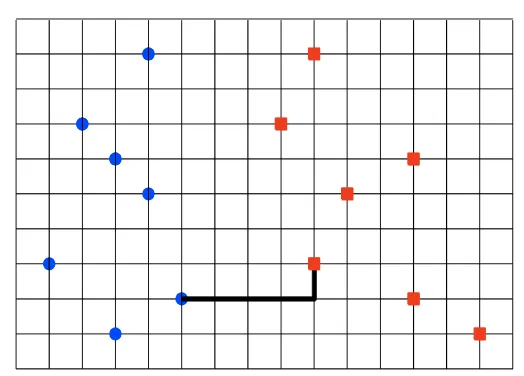
这个问题是在两个不相交集合之间求最近点对。 上面的图片表示了这个问题。有两种不相交的集合,-x平面上的蓝色点和+x平面上的红色点。
我想要计算一个蓝点和一个红点之间的最小距离 (距离为 |y2-y1| + |x2 - x1|) ,而且我认为使用二分查找来寻找距离。如何在这种情况下使用二分查找呢? 我遇到的困难在于将两个不相交集合表达为二分查找。我已经知道了单个集合的情况,但我不知道在两个不相交集合的情况下应该怎么做。
++ ) 使用Delaunay三角测量可以在线性时间内解决吗?(啊,这只是我的好奇心,我想使用二分查找)
下面的代码是我已经编写的一个集合情况的代码(使用问题解决技术、分治),并转化为两个不相交集合。我不明白在两个集合的情况下该怎么做。 例如,提示。好吧,请有人帮帮我?
#include <iostream>
#include <algorithm>
#include <iomanip>
#include <cmath>
/**
test input
10
-16 -4
-1 -3
-9 -1
-4 -10
-11 -6
-20 4
-13 6
-3 -10
-19 -1
-12 -4
10
8 2
10 3
10 10
20 -3
20 3
16 2
3 -5
14 -10
8 -2
14 0
10
-3 39
-2 -28
-1 20
-3 11
-3 45
-2 -44
-1 -47
-5 -35
-5 -19
-5 -45
10
27 5
28 0
28 5
21 5
2 3
13 -1
16 -2
20 -2
33 -3
27 1
**/
using namespace std;
const int MAX = 10001;
struct point{
int x,y;
};
bool xCompare(struct point, struct point);
bool yCompare(struct point, struct point);
int dis(struct point, struct point);
int absd(int);
int trace(int,int,int,int);
point p[MAX], q[MAX], tmp[MAX];
int main(){
int left;
int right;
scanf("%d\n", &left);
memset(p,0,sizeof(p));
memset(q,0,sizeof(q));
memset(tmp,0,sizeof(tmp));
for(int i=0; i<left; i++){
cin >> p[i].x >> p[i].y;
}
scanf("%d\n", &right);
for(int j=0; j<right; j++){
cin >> q[j].x >> q[j].y;
}
sort(p, p+left, xCompare);
sort(q, q+right, xCompare);
int min = trace(0,0, left-1, right-1);
printf("%d\n", min);
/** this is one set case.
while(true){
cin >> n;
if(n == 0) break;
memset(p,0,sizeof(p));
memset(tmp,0,sizeof(tmp));
for(int i= 0;i<n;i++)
cin >> p[i].x >> p[i].y;
sort(p,p+n,xCompare);
int min = trace(0,n-1);
if(min < 10000 && n > 1){
cout << fixed;
cout << setprecision(4) << min << endl;
}
else
cout << "INFINITY" << endl;
}
**/
return 0;
}
int trace(int low1, int low2, int high1, int high2){
if(high1 - low1 < 3){
int value = dis(p[low1],q[low2+1]);
int nextValue;
if(high1 - low1 == 2){
nextValue = dis(p[low1],q[low2+2]);
if(value > nextValue)
value = nextValue;
nextValue = dis(p[low1+1],q[low2+2]);
if(value > nextValue)
value = nextValue;
}
return value;
}
else{
/* DIVIDE & QONQUER */
int mid1 = (low1 + high1) >> 1;
int mid2 = (low2 + high2) >> 1;
int cnt = 0;
int leftValue = trace(low1,low2,mid1,mid2); // left trace
int rightValue = trace(mid1+1,mid2+1,high1,high2); // right trace
// min value find
int value = leftValue < rightValue ? leftValue : rightValue;
/* Middle Condition Check : Y Line */
// saving left
for(int i = low1;i<=mid1;i++){
if(abs(p[i].x - q[mid2].x) <= value)
tmp[cnt++] = p[i];
}
// saving right
for(int i = mid1+1;i<=high1;i++){
if(absd(p[i].x - q[mid2+1].x) <= value)
tmp[cnt++] = p[i];
}
sort(tmp,tmp+cnt,yCompare);
for(int i = 0;i<cnt;i++){
int count = 0;
for(int j = i-3;count < 6 && j < cnt;j++){
if(j >= 0 && i != j){
int distance = dis(tmp[i],tmp[j]);
if(value > distance)
value = distance;
count++;
}
}
}
return value;
}
}
int absd(int x){
if( x < 0)
return -x;
return x;
}
int dis(struct point a, struct point b){
return (abs(a.x-b.x) + abs(a.y-b.y));
}
bool xCompare(struct point a, struct point b){
return a.x < b.x;
}
bool yCompare(struct point a, struct point b){
return a.y < b.y;
}